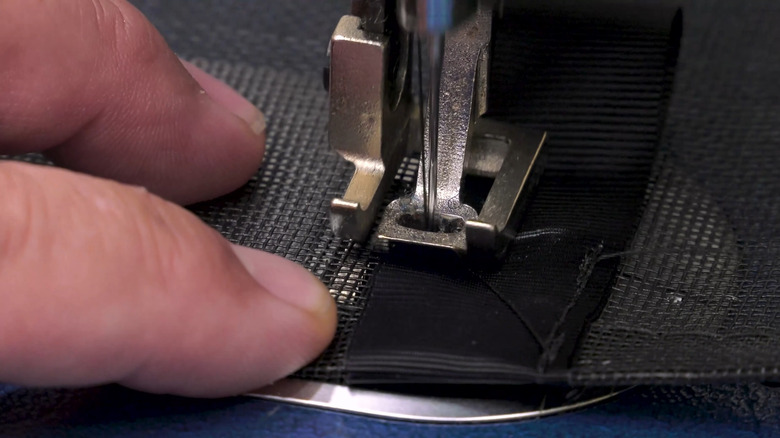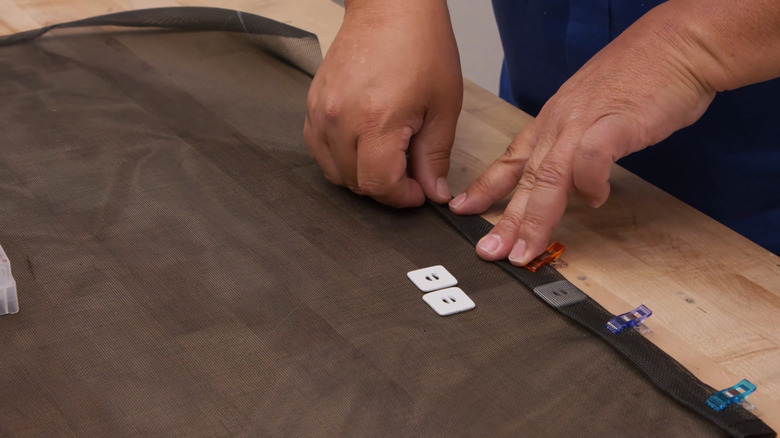DIY An Affordable And Simple Screen Door Using Magnets
We may receive a commission on purchases made from links.
Lots of good ideas for everyday living come from those who live quite differently than the norm. For example, many interesting approaches to home organization, living in a small space, and outdoor recreation come from sailing. We've long been fans of Sailrite's (mostly) sailing-focused, (mostly) sewing-centered DIY videos, from which one can learn a lot of skills. When we ran across this very well-made DIY magnetic screen door project on its YouTube channel, we thought we should share it — and improve on it just a little. Magnetic screen doors are the right choice for many homes, so why not make the best custom-fitted door you can?
Not that the quality of the workmanship needs improving — it is, as we said, very well-made. Sailrite makes industrial-quality walking-foot sewing machines and sells a comprehensive assortment of sewing tools and supplies with something of a sailing focus. The employees know their stuff and don't cut corners, as evidenced by the materials list for this project: neodymium disc magnets ($7.48), fiberglass mesh screen ($10.95), tailor's chalk ($2.95), V-69 thread ($17.95), drapery weights ($5.25), basting tape ($6.75), polyester binding ($9.50, or $4.50 for an alternative), nylon hook and loop tape ($2.20), YKK SNAD fasteners ($10.50), DOT snap fastener buttons ($1.50 each), and DOT snap fastener sockets ($1.20 each). If you're keeping track, you know that's around $70 total ... a bit rich for something you can pick up at Home Depot for $19.38 (for a 36-inch x 82-inch door). So we also went looking for ways to make this custom screen door less expensive.
How the Sailrite screen door is made
What's so great about the Sailrite magnetic screen door? Well, just about every detail. It's made to fit your particular door. All four sides are double-hemmed, and the bottom is given the weight to stand straight with sewn-in drapery weights. There are reinforced pull tabs for opening the screen without stressing the stitching, as well as sewn-in hook-and-loop-tipped straps for rolling the screen up temporarily or for storage. Neodymium disc magnets — the sort you can use to instantly magnetize screwdrivers — hold the material taut, and it's also supported by a row of snaps installed across the top. The fiberglass mesh itself is vinyl-coated for durability and ease of cleaning.
Unless you're an expert at sewing, this is probably an afternoon-long project. After cutting the door to size (allowing an extra 2 inches for the width and 4 inches for the height), you sew on the ½-inch (along the long edges) and 1-inch (along the top and bottom) double hems, incorporating drapery weights and magnets along the way. The pull tabs are actually loops with magnets underneath the sewn portion (make sure the right sides of your magnets are facing out!). And the pricey YKK adhesive snaps are a great idea for a boat but overkill anywhere you can drill a small hole.
Making an affordable, less sailing-focused version
Toning down the price on this project is a function of both getting rid of unnecessary details and replacing expensive options with cheaper ones. The drapery weights, for example, don't have to be store-bought. Just about anything heavy you can sew into the mesh will do the trick — metal rod, wood dowel, or pennies (a hack that can also fix your wrinkled curtains). And the magnets themselves, the defining features of the Sailrite screen door, aren't that expensive, but you could replace them with leftover scraps of the inexpensive sew-on hook-and-loop tape used for the closure straps.
Some of the most expensive materials, the YKK SNAD fasteners, are completely unnecessary if you can drill holes and install screw-in canvas snap fasteners. The $4.10 set at Walmart also replaces the DOT snaps. You can also skip the sewing and attach the screen to a length of dowel or other scrap and wedge it into the door frame — a less elegant but perfectly serviceable solution. Elsewhere, you can save a couple bucks by buying a screen alternative like this charcoal fiberglass mesh from Lowes ($8.48). Assuming you have marking chalk and thread on hand, that brings your expenses to around $20 — not bad for a custom-sized removable screen door.


